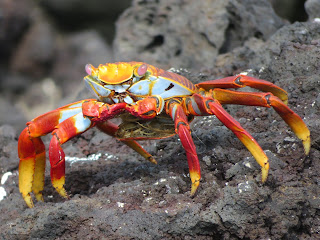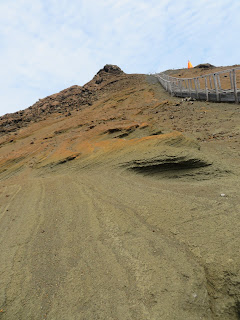, as always. So he waved his hat and swatted his whiskers. Apparently sea lions don't want anybody touching their whiskers so he finally got out of her way and allowed us to get onto the island. We walked along the broadwalk and saw the Ahi type of lava lava mud and pahoehoe lava. Louis explain the origins and Creations of each type of lava and then showed us examples of it. About midway up there was a very alien landscape that Leslie said looked like the Moon. Louis laughed and said that Buzz Aldrin had actually visited that area and told them this was the place that looked closest to what the moon looked like! We were able to lift lava stones that had large amounts of trapped gases in them versus lava stones that had no gas and we're very heavy in comparison. We hiked to the top for glorious views of the island of Bartolome as well as James Island. The most distinctive part of the view was the Pinnacle rock. It was part of a cinder cone that was more dense than the rest of the cone and was left standing. Its distinctive shape however was changed by World War II Pilots that did practice runs with torpedoes on the Pinnacle. The torpedoes were not filled with explosives but they were filled with sand and had a lot of momentum which slowly chipped away at the shape of the rock. The government has since cleared out all of the old torpedo tubes but the shape of the rock is still quite distinctive to this day.
Pikaia 1 bow
James Island in the distance and Pinnacle Rock to the right
Pinnacle rock is quite tall over a hundred feet
It looks a bit like a turtle with a raised head
Sea lion on the stairs
He is not moving out of the way
is the Sally Lightfoot crab
A submerged Caldera
A lava lizard endemic to this island only
Different layers of lava mud or tuff
The pioneer species of cactus. The first generation grows and then Falls and disintegrates after dropping at seeds. The disintegrated Cactus access soil for the next generation
Lava tubes and different flow areas
A collapsed lava tube
A lava lizard climbing a bit of bush to try and get a better view of the surroundings
Another Pioneer plant that is currently dormant with the exception of a lava lizard
Luis is not superman, the rock is actually very light
A moon like landscape
Lava rock curls
An expanse of lava mud
Almost to the top
Looking over at James Island you can see fresh lava flow that is brown compared to the other coloration of the surrounding rocks
Looking further south you can see the black lava that is lower down which is part of the 30 square mile lava flow
The last set of 100,000 stairs to the top
Yes we made it to the top
our boat looks so small way down there
The lighthouse is very distinctively Orange
The submerged Caldera as viewed from the top



























